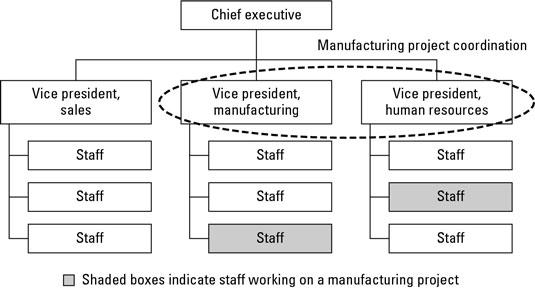Project managers need tools for overseeing their projects. The functional organization structure brings together people who perform similar tasks or who use the same kinds of skills and knowledge in functional groups. In this structure, people are managed through clear lines of authority that extend through each group to the head of the group and, ultimately, to a single person at the top.
In the image example, you see that all people who perform human resources functions for the organization (such as recruiting, training, and benefits management) are located in the human resources group, which reports to the chief executive:

Depending on the nature of the project and the skills and knowledge required for it, a project in the functional structure may be handled completely by staff within a particular functional group. However, if the manufacturing group is performing a project that requires the expertise of a person from the human resources group, the vice president of manufacturing must make a formal agreement with the vice president of human resources to make the necessary human resources staffer available to work on the project. The vice president of human resources must then manage this person as he performs his tasks for the project.
The project manager has less authority over project team members in the functional structure than in any other form of project organization. In fact, he serves more as a project coordinator than a project manager because the functional managers maintain all authority over the project team members and the project budget.
The functional structure has the following advantages:
Functional groups are reservoirs of skills and knowledge in their areas of expertise. Group members are hired for their technical credentials and continue to develop their capabilities through their work assignments.
Functional groups’ well-established communication processes and decision-making procedures provide timely and consistent support for the group’s projects. From the beginning of their assignments, group members effectively work with and support one another because they know with whom, how, and when to share important task information. Decisions are made promptly because areas of authority are clearly defined.
Functional groups provide people with a focused and supportive job environment. Group members work alongside colleagues who share similar professional interests. Each member has a well-defined career path and one boss who gives his assignments and reviews his performance. The established interpersonal relationships among the group’s members facilitate effective collaborative work efforts.
The functional structure has the following drawbacks:
The functional structure hampers effective collaboration between different functional groups. Group members’ working relationships are mainly with others in their group, and management assesses their performance on how well they perform in the group’s area of specialization. This makes effective collaboration with other groups on a project difficult.
The functional group members’ main interest is to perform the tasks in their group’s specialty area effectively, rather than to achieve goals and results that may involve and affect other groups in the organization. Group members’ professional interests and working relationships are mostly with others in their group, and their boss, who gives them their work assignments and evaluates their performance, is the head of the functional group. This environment encourages members to be most concerned with and to give the highest priority to their functional group’s task assignments.
A functional group may have difficulty getting buy in and support for its project from other functional groups that must support or will be affected by the project. Each functional group can initiate a project without consulting other functional groups. As a result, people in these other areas may be reluctant to support such a project when it doesn’t address their needs in the most effective way. They may also be reluctant to support it because the project may be competing with projects from their own functional group for scarce resources.

